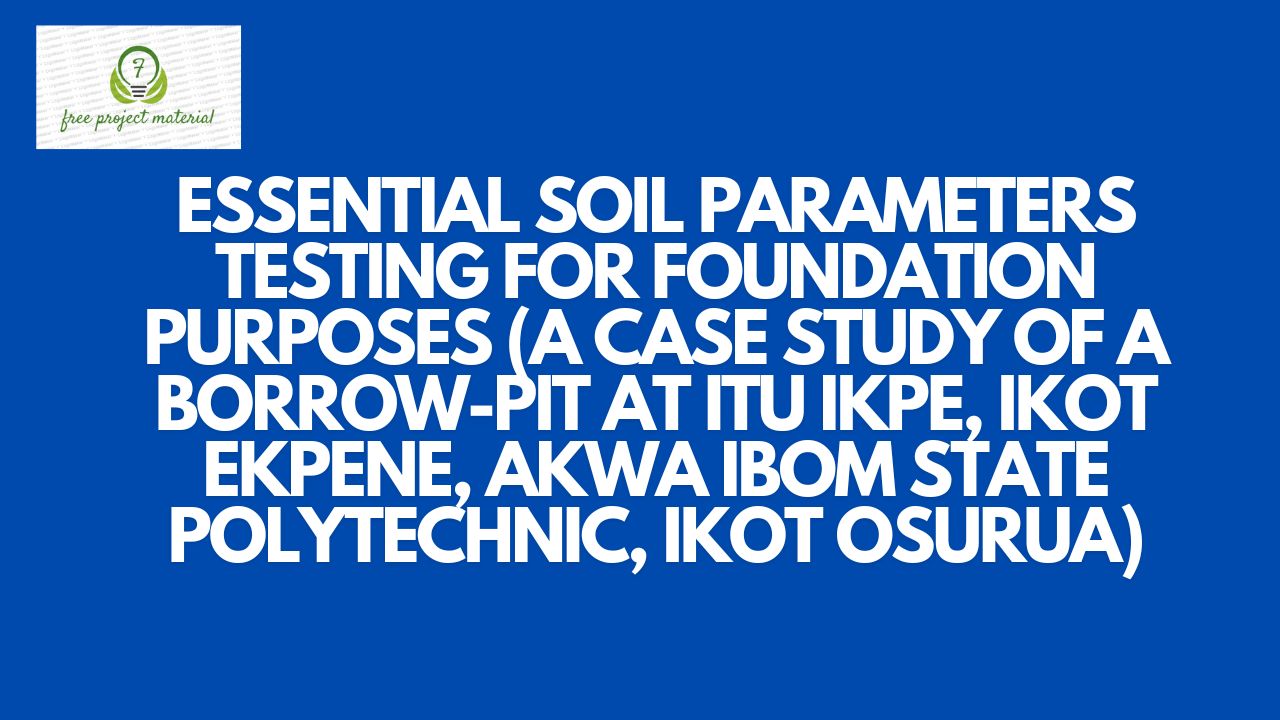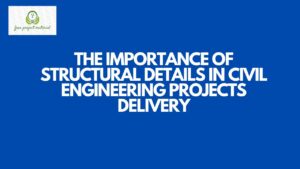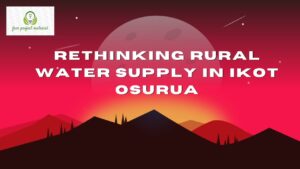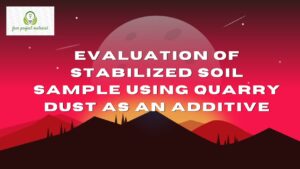ABSTRACT
Soil sampling and testing is one of the most important steps to attain success in construction project. Soil testing provides information on type of soil, bearing capacity of soil Test such as liquid limit, plastic limit, atterbergs, compaction, plastic index test and differential free swell test are done for testing the suitability and stability of soil for the construction of commercial complex.
TABLE OF CONTENTS
Contents Pages
Title Page – – – – – – – – – i
Certification – – – – – – – – ii
Dedication – – – – – – – – – iii
Acknowledgements – – – – – – – iv
Abstract – – – – – – – – – v
List of Table – – – – – – – – vi
List of Figures – – – – – – – – vii
Table of Contents – – – – – – – – viii
CHAPTER ONE
1.0 INTRODUCTION – – – – – – 1
1.1 Aim and Objective of the Study – – – – – 3
1.2 Statement of the Problem – – – – – 3
1.3 Scope of the Study – – – – – – 4
1.4 Definition of Terms – – – – – – 4
CHAPTER TWO
2.0 LITERATURE REVIEW – – – – – 7
2.1 Deep Foundation – – – – – – – 8
2.2 Pile Foundation System – – – – – – 9
2.3 Literation in Foundation – – – – – – 12
2.4 Sieve Analysis – – – – – – – 15
2.4.1 Procedure – – – – – – – – 16
2.4.2 Preparation – – – – – – – – 17
2.4.3 Methods – – – – – – – – 20
2.4.4 Types of Gradation – – – – – – 24
2.4.5 Types of Sieves – – – – – – – 25
CHAPTER THREE
3.0 MATERIALS AND METHOD – – – – 30
3.1 Laboratory Investigation – – – – – – 30
3.2 Materials – – – – – – – – 31
3.3 Grain Size Analysis Test – – – – – – 31
3.4 Atterberg Limit Test – – – – – – 34
3.4.1 Liquid Limit – – – – – – – 34
3.4.2 Plastic Limit Test – – – – – – – 38
3.4.3 Plastic Index – – – – – – – 40
3.5 Compaction Test – – – – – – – 41
CHAPTER FOUR
4.0 DATA ANALYSIS AND RESULT PRESENTATION
4.1 Sieve Analysis – – – – – – – 44
4.2 Attergberg Limits – – – – – – – 50
4.2.1 Result/Calculation of Liquid Limit Determination – – 50
4.2.2 Result/Calculation of Plastic Limit Determination – – 51
4.3 Moisture – Density (Compaction Test) – – – 53
CHAPTER FIVE
5.0 CONCLUSION AND RECOMMENDATION
5.1 Conclusion – – – – – – – – 57
5.2 Recommendation – – – – – – – 57
References
Appendix
CHAPTER ONE
1.0 INTRODUCTION
Soil testing is an important diagnostic tool for determining the nutrient needs of plant and for environmental assessments.
As a result, one needs to identify and ascertain the characteristics of the soil concerned in order to determine its suitability for the intended structure.
This is a common procedure, but should be used judiciously to avoid skewing result; this procedure must be done so that government sampling requirements are met. A reference map should be created to record the location and quality of field samples in order to properly interpret test result.
The soil is the most important yet most neglected in most construction projects. All structures, building, roads, bridges, dams and even life itself is on the soil.
The soil is the natural foundation that supports all the structures and investment.
Thus, soil testing is widely accepted and used in most advanced crop-production areas of the world to determine fertilization and analysis and check settlement. Other soil test may be done for engineering geotechnical, geochemical.
The important of soil test cannot be overemphasized it saves lives and reduces cost; soil test is conducted to discover the characteristic of soil at the particular location.
This is done by conducting soil tests which involves the following steps:
- Planning the details and sequence of operations collection of soil sample from the field
- Conducting all field test for determining the strength and compressibility of the soil.
- Preparation of report
- Analysis of the result of the test
- Testing in the laboratory of all samples of soil rock and water.
Site investigation are needed to gain an understanding of the area in or which the engineering will take place.
Important concepts include the meaning of a soil test valve, soil-testing quality, use of soil testing to determine economically optimum nutrient application rates, and use of soil testing for environmental assessments.
1.1 AIM AND OBJECTIVE OF THE STUDY
- Conducting all field test for determining the strength and compressibility of the soil.
- Analysis of the result of the test.
- To determine the suitability of the soil and assess whether it can accommodate your construction projects.
- Testing in the laboratory of all samples of soil rock and water.
- To determine the nature of soil.
- Its enable you to assess the suitability of soil.
- To determine its ability to support your structure.
1.2 STATEMENT OF THE PROBLEM
Soils have to be tested before any planning of structure to know whether it will bring destruction or working good. Without soil been testing; the type and depth of foundation sometime may not appear accurately according to plan. It is very useful and important to do soil test to know the future of the soil. Some foundation do select the soil sometimes. Soil have to be tested in difference location to know the area of the soil that could bring discomfort to your structure.
Soil test help in determining varying physical and chemical characteristic of soil which can vary from place to place, and from layer to layer within the limit of the proposed structure. It is much important to do soil test to obtain the require information concerning the nature of the superstructure and load to be transmitted to the foundation, and soil test help in obtaining the possibility of constructing any of the type of foundation under existing condition by taking into account.
1.3 SCOPE OF THE STUDY
All the analysis are based on the soil samples from a borrow pit located at Itu-Ikpe, Ikot Ekpene as a case study, the parameters show cased in the research work are the only ones, for which equipment were available within the confines of the polytechnic .
1.4 DEFINITION OF TERMS
ANALYSIS: This is the process of breaking complex topic or substance into smaller understanding of it.
CAPABILITY: The power or ability to do something.
COMPACTION: This is the process of increasing soil density by removing air voids. It is done by mechanical means.
CONTINUOUS: Physical force external on or against an object of something in contact with it.
DESICCATOR: A glass container or other apparatus holding a drying agent for removing moisture from specimens and protecting them from water vapors in the air.
DETERMINE: To discover the facts about (something) to occur in a particular way or to have a particular or firm decide.
DRY DENSITY: The weight of a unit volume of a dry sample of soil, after the latter has been heated at a temperature of 103 degrees c
GROOVING: This is a deep line cut into a surface or long, narrow cut or depression in hand material.
IMMEDIATELY: At once instantly.
ISOTROPIC: Identical in all directions; invariant with respect to direction. As conductivity, elasticity, etc.
MASS: A large body of matter with no definite shape.
MIAMETE: A straight line passing from one side to the other through the centre of the body or figure, especially a circle or sphere.
RAMMER: Was a wooden cylinder about the same diameter and length as the shot.
SIEVES: A tool for separating solids from liquids or larger solids from smaller solids made of wire or plastic not attached to ring.
SPATULA: An implement with a broad, flat, usually flexible blade, use for blending food or removing them from cooking utensils or spread soft substance.
SUB-SURFACE: Being something located beneath a surface and especially underground.
VISCOELASTIC: This is the property of materials that exhibit both viscous and elastic characteristics when undergoing deformation.
WATER CONTENT: Water or moisture content is the quality of water contained in a material, such as soil (called soil moisture).



